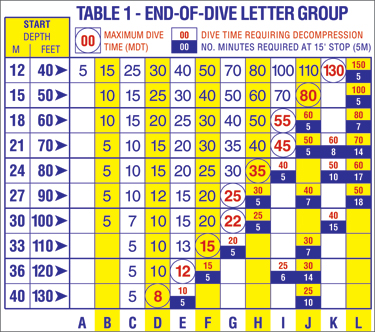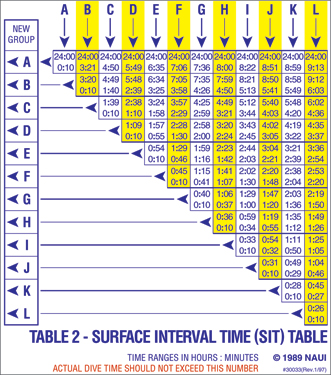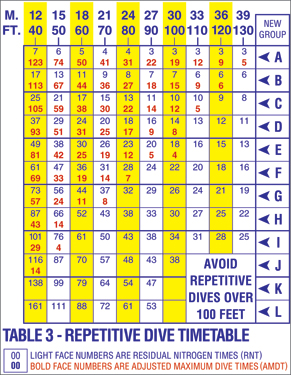
The NAUI Dive Tables use a Letter Group designation to express the amount of residual nitrogen in your body. The letters range in sequence from A to L. The letter A represents a small amount of nitrogen and the amount of nitrogen increases as the letters progress towards L. When you dive, a Letter Group from the tables designates the amount of nitrogen you have absorbed during the dive. As you spend time on the surface between dives, you are assigned to “lower” Letter Groups as you offgas nitrogen.
Would You Rather Plan Your Dives the Modern Way? Use This Instead, We do.
When you start a dive again to a given depth, your Letter Group at that time determines the time representing the residual nitrogen in your body. The tables show you how to subtract this time from the normal dive time limits, which results in a shorter time limit for your repetitive dive. You must add your residual nitrogen time to the time you actually spent diving to determine your total nitrogen time at the end of the dive. You use the total time to determine a new end-of-dive Letter Group. The NAUI dive time calculator is based on the NAUI dive tables, but it eliminates the calculations required to determine Letter Groups when you make more than one dive. The dive time calculator also reduces the errors that are often made when reading dive tables. It is easy to learn how to use a dive time calculator, but you should do this only after you are familiar with the procedures for planning dive time limits using the dive tables. A dive time calculator might not always be available, but dive tables usually are (figure 5-4).
A variety of dive tables, dive time calculators, and dive computers exist. The information they provide varies and some are more conservative than others. Numbers and Letter Groups are not always interchangeable between tables. Always use the type of table, calculator, or computer with which you are familiar. If your dive buddy is using a different type, you should agree to use the most conservative dive planning information.
Dive Table Organization - Get Training from a Current and Qualified NAUI Professional Diver. A dive instructor can have you up to speed and proficient in the use of dive tables in just a few minutes. Take a Class. Do a Refresher Class. Plan Safely before you Dive with Scuba.
The NAUI Dive Tables are composed of three tables:
- Table 1 – End-Of-Dive Letter Group
- Table 2 – Surface Interval Time (SIT) Table
- Table 3 – Repetitive Dive Timetable
The NAUI Dive Tables are based on the US Navy Decompression Tables and have been designed specifically for recreational diving (figure 5-6). The tables are designed to flow from one to the other in a continuous loop (figure 5-7).
When you are using the tables, be sure to use a ruler or a straight-edged object to read the numbers across and work your way from table to table. If you try using a finger to trace your path through the tables, you might slide into another row and read the table incorrectly, especially if you are on a rocking boat.
-
TABLE 1: End of Dive Lettergroup

- after you exit table 1 with your letter group
- Enter Table 2 to calculate the SIT
-
TABLE 2: Surface Interval Time (SIT)

- Did you know that Hollywood Divers Sells and Services all major brands of Diving Gear ?
- Hollywood Divers Beats Amazon.
-
Hollywood Divers is Run by Experienced Divers who Personally use the Equipment That We Sell.
-
TABLE 3: Repetitive Dive Timetable

Dive Table Terms
Different dive tables and dive computers might use terms different from the ones used in the NAUI Dive Tables (figure 5-5). Also, the same term might have a different meaning.
The following terms apply to the NAUI Dive Tables:
- Dive Schedule
- This is an abbreviated statement giving the depth and time of the dive. It is expressed as depth/time (for example, 21 meters/40 minutes or 70 feet/40 minutes). It is also called a dive profile, especially when it is one dive in a sequence of dives.
- Maximum Dive Time (MDT)
- This is the time you can spend at a given depth without having to do a required decompression stop during ascent. This time is also known as the Maximum Allowable Dive Time or no-decompression ddmit.
- Decompression Stop
- This is a point in a dive where you stop at a specified depth for a specified time during ascent to allow nitrogen offgassing before continuing your ascent or surfacing.
- Precautionary Decompression Stop
- This is a stop at five meters (15 feet) for three minutes as a safety precaution when you have not exceeded the Maximum Dive Time. You should perform such a stop at the end of every dive. It is also known as a Safety Stop.
- Required Decompression Stop
- This is the amount of time specified by the NAUI Dive Tables, that you must spend at five meters (15 feet) whenever you exceed the Maximum Dive Time. Other tables specify additional stop depths for deeper or longer dives.
- Actual Dive Time (ADT)
- This is the elapsed time from the moment you begin your descent from the surface until the time you return to the surface. Time spent at your Safety Stop does not need to be included in the Actual Dive Time when determining your Letter Group.
- Residual Nitrogen
- This is the excess nitrogen remaining in your body from any dive or dives made before you have completely offgassed.
- Letter Group Designation
- This letter symbol identifies the amount of residual nitrogen you have in your system. The closer the letter is to the beginning of the alphabet, the less residual nitrogen you have in your body.
- Surface Interval Time (SIT)
- This is the time spent on the surface between dives. During this time, your body is eddminating excess nitrogen. Your Letter Group will change and move closer to the beginning of the alphabet, depending on how long you are on the surface.
- Repetitive Dive
- This is any dive that you make before you have completely offgassed from any previous dive or dives.
- Residual Nitrogen Time (RNT)
- This is the amount of time you must consider as already having been spent at a given depth for a planned repetitive dive. This time is based on the residual nitrogen remaining in your body from a previous dive or dives.
- Adjusted Maximum Dive Time (AMDT)
- This is the Maximum Dive Time minus the Residual Nitrogen Time for a repetitive dive to a given depth.
- Total Nitrogen Time (TNT)
- This is the sum of your Residual Nitrogen Time and your Actual Dive Time following a repetitive dive. You use this total to obtain your new Letter Group at the end of the dive.
Dive Table Rules
You must understand the following NAUI Dive Table rules completely. Similar rules will apply to any new set of dive tables or dive computer that you might use to calculate your dive times.
- Ascend no faster than 9 meters (30 feet) per minute. This is 0.3 meters (1 foot) every two seconds. You need a timing device and a depth gauge (or a dive computer) to measure your rate of ascent. This rate will seem quite slow to you.
- Use the exact or the next greater number listed in the table for your depth. If you exceed a number in the table, use the next greater number. The depths in the table range from 12 meters (40 feet) to 40 meters (130 feet) and increase in increments of 3 meters (10 feet). For example, you round a dive to 13 meters (43 feet) up to a 15 meter (50 foot) dive.
- Use the exact or the next greater number listed in the table for your time. If you exceed a number in the table, use the next greater number. The times range from 5 minutes to 130 minutes. For example, you round a dive to 15 meters (50 feet) for 41 minutes up to 50 minutes.
- Use the deepest depth you reached during your dive to determine the dive schedule for your dive. For example, if you do a dive to 18 meters (60 feet), but spend most of the time at 12 meters (40 feet), you must consider the dive to be an 18 meter (60 foot) dive.
- Always make your deepest dive first when making a series of dives. Plan each of your repetitive dives to a shallower depth than your previous dive. This might allow you to offgas nitrogen on progressively shallower dives and prevents you from carrying progressively larger amount of residual nitrogen on deeper repetitive dives.
- Consider any dive shallower than 12 meters (40 feet) to be a 12-meter (40-foot) dive when planning your dives.
- Surface Interval Time (SIT) must be at least 10 minutes between dives. If your SIT is less than 10 minutes, you must consider your second dive as a continuation of the first dive. NAUI recommends a SIT of at least one hour between dives.
- Use the next greater dive time if your dive is particularly cold or strenuous. For example, if you do a dive to 18 meters (60 feet) for 22 minutes, the 22 minutes rounds to 25 minutes. However, if you become chilled during the dive, round the time again to 30 minutes.
- Avoid dives that take you right to the no-decompression limit for any given depth and time combination. If you accidentally overstay your bottom time or use an incorrect ascent rate on such a dive, you could be in a required decompression situation or suffer DCS. Always allow yourself enough time to make a slow, comfortable ascent with plenty of air




